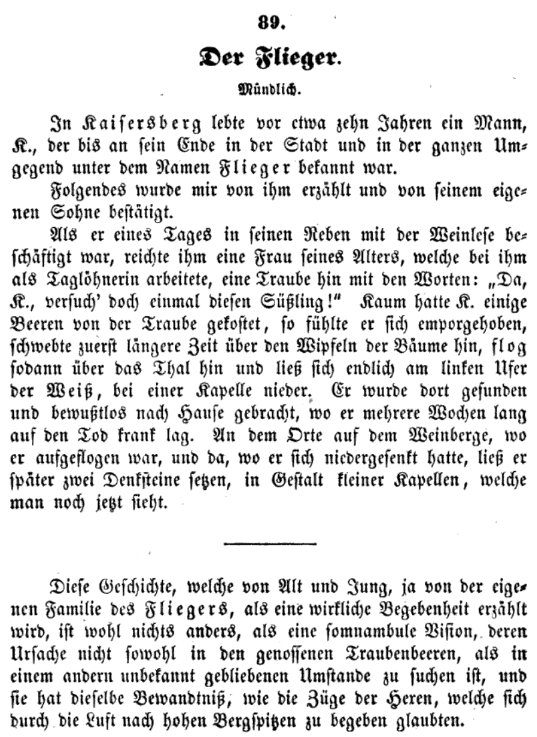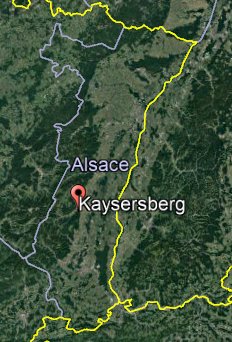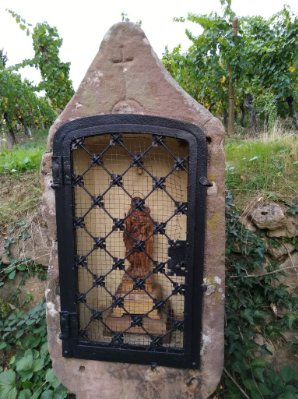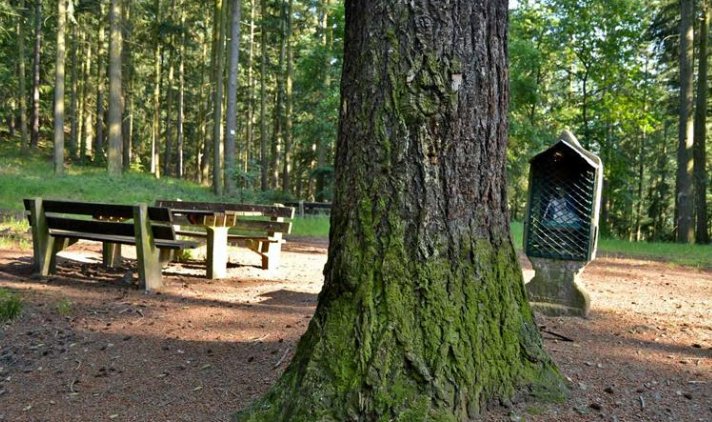ALSACAT-1800-00-00-KAYSERSBERG-1
In his book about UFOs in Alsace, in a chapter devoted to legends and celestial wonders before the era of flying saucers in Alsace, Christian Valentin reports a letter from a reader in the Kaysersberg section of the regional newspaper Le Nouveau Rhin Français for October 30, 1954.
The letter was titled: "Wasn't that already in those days flying saucers and Martians?"
This reader reported that in light of the flying saucers of that year, 1954, ancient Alsatian legends collected by Auguste Stoeber might take on new interest.
One of them is reported by this reader as follows:
Another legend mentions an event that could be attributed to the inhabitants of Mars: around 1800, there lived in Kaysersberg a certain Kohlmann family, famous, and whose lane in the city bears today still the name. This one was nicknamed Flieger (the one who flies) until the end of his days. While he was harvesting his vines at the entrance to the Toggenbach valley, a woman handed him a bunch. No sooner had he tasted a few berries than an incredible force lifted him to carry him through the air to the Furtiberg where he was again deposited on the ground. At this place, as well as at the place where he was carried away, Kohlmann had a chapel built, which is still known today as the Fliegerkapelle.
| Date: | 1800 |
|---|---|
| Time: | Day. |
| Duration: | ? |
| First known report date: | 1852 |
| Reporting delay: | Decades. |
| Department: | Haut-Rhin |
|---|---|
| City: | Kaysersberg |
| Place: | |
| Lieu: | 48.145 |
| Latitude: | 7.258 |
| Uncertainty radius: | 100 m. |
| Number of alleged witnesses: | 1 |
|---|---|
| Number of known witnesses: | 1 |
| Number of named witnesses: | 1 |
| Witness(es) ages: | Young adult or adult. |
| Witness(es) types: | Vineyard worker or owner. |
| Reporting channel: | To folklorist Auguste Stoeber. |
|---|---|
| Type of location: | Vineyard. |
| Visibility conditions: | Day. |
| UFO observed: | No. |
| UFO arrival observed: | N/A. |
| UFO departure observed: | N/A. |
| Entities: | No. |
| Photographs: | No. |
| Sketch(s) by witness(es): | No. |
| Sketch(es) approved by witness(es): | No. |
| Witness(es) feelings: | Puzzled, frightened. |
| Witnesses interpretation: | ? |
| Hynek: | N/A |
|---|---|
| ALSACAT: | Possible narcolepsy episode. |
[Ref. asr1:] AUGUSTE STOEBER:

|
In Kaisersberg lebte vor etwa zehn Jahren ein Mann, K., der bis an sein Ende in der Stadt und in der ganzen Umgegend unter dem Namen Flieger bekannt war.
Folgendes wurde mir von ihm erzählt und von seinem eigenen Sohne bestätigt.
Als er eines Tages in seinen Reben mit der Weinlese beschäftigt war, reichte ihm eine Frau seines Alters. welche bei ihm als Taglöhnerin arbeitete, eine Traube hin mit den Worten: "Da, K., versuch' doch einmal diesen Süßling!" Kaum hatte K. einige Beeren von der Traube gekostet, so fühlte er sich emporgehoben, schwebte zuerst längere Zeit über den Wipfeln der Bäume hin, flog sodann über das Thal hin und ließ sich endlich am linken Ufer der Weiß, bei einer Kapelle nieder. Er wurde dort gefunden und bewußtlos nach Hause gebracht, wo er mehrere Wochen lang auf den Tod krank lag . An dem Orte auf dem Weinberge, wo er aufgeflogen war, und da, wo er sich niedergesenkt hatte, ließ er später zwei Denksteine sehen, in Gestalt kleiner Kapellen, welche man noch jest sieht.
Diese Geschichte, welche von Alt und Jung, ja von der eigenen Familie des Fliegers, als eine wirkliche Begebenheit erzählt wird, ist wohl nichts anders, als eine somnambule Vision, deren Ursache nicht sowohl in den genossenen Traubenbeeren, als in einem unbekannt gebliebenen Umstande zu suchen ist, und sie hat dieselbe Bewandtniss wie die Züge der Heren, welche sich durch die Luft nach hohen Bergspißen zu begeben glaubten. Das opiurn," sagt Ennernoser in seiner Geschichte der Magie (Leipzig 1 1844, S. 108), erzeugt Visionen Kaisersberg.
French translation:
About ten years ago there lived in Kaisersberg, K., a man who was known in the city and throughout the region as "Flieger" [the man who flies] until the end of his life.
The following was told to me by him and confirmed by his own son.
One day, while he was busy harvesting his vines, a woman of his age who worked like him as a farm hand handed him a grape with these words: "There, K., taste this sweetness!" K. had barely tasted a few grapes than he felt lifted, he first hovered for a long time over the treetops, then flew over the valley and finally landed on the left bank of the Weiss, near a chapel. He was found there and brought home unconscious, where he remained on the verge of death for several weeks. At the place in the vineyard where he had taken off and where he had landed, he later showed two memorial stones in the form of small chapels, which can still be seen.
This story, which is told by the young and the elders, and even by the flying man's own family, as a real event, is probably only a somnambulistic vision, the cause of which is not so much in the berries of grapes consumed but in a circumstance remaining unknown and to be sought, and it has the same meaning as the steps of the Gentlemen, who believed that they went through the air towards the high peaks of the mountains.
[Ref. cvn1:] CHRISTIAN VALENTIN:
In his 1st chapter devoted to legends and celestial wonders before the era of flying saucers in Alsace, Christian Valentin reports a letter from a reader in the Kaysersberg section of the regional newspaper Le Nouveau Rhin Français for October 30, 1954.
The letter was titled: "Waren es nicht damals schon fliegenden Untertassen und Marsbewohner?" i.e. "Wasn't that already flying saucers and Martians in those days?"
This reader reported that in light of the flying saucers of that year, 1954, ancient Alsatian legends collected by Auguste Stoeber might take on new interest.
One of them is reported by this reader as follows:
Another legend mentions an event that could be attributed to the inhabitants of Mars: around 1800, there lived in Kaysersberg a certain Kohlmann family, famous, and whose lane in the city bears today still the name. This one was nicknamed Flieger (the one who flies) until the end of his days. While he was harvesting his vines at the entrance to the Toggenbach valley, a woman handed him a grape. No sooner had he tasted a few berries than an incredible force lifted him to carry him through the air to the Furtiberg where he was again deposited on the ground. At this place, as well as at the place where he was carried away, Kohlmann had a chapel built, which is still known today as the Fliegerkapelle.

|
The "chapel" of the flying man of Kaysersberg, at the place where he would have taken off, actually still exists, it is at the edge of the vineyards in the rue de la Flieh in Kaysersberg, known as the "Fliegerkapelle" or "Flieger Kapelle" or even "Chapelle Flieger:"

|
The "chapel" of the flying man of Kaysersberg, at the place where he would have landed, actually still exists, it is a picnic area, known as "Fliegerkapelle" or "Flieger Kapelle" or even "Flieger Chapel":

|
The place of arrival is a few minutes walk from the place of departure.
There is indeed a "rue du Père Kohlmann" in Kaysersberg.
As often, this local legend has known variations. Here is one:
In the heart of the Kaysersberg valley, between fruitful vines and deep forest, the story of the Flying Man has been passed down for many generations.
Behind this name hides the fantastic adventure of a young winegrower from Kaysersberg.
One day during the harvest, after having accomplished the hard work of harvesting, a charming young girl suggested that the seasonal worker should taste a very appetizing grape. Letting himself be thus charmed by the proposal of his new friend and filled with passion, he bit vigorously into the fruit.
Immediately after the first bite, he felt a warmth rise inside him, and wings began to shoot out of his back. Quickly, he was carried through the air, skirting the tops of the trees and soaring through the valley. After flying over the village, its journey ended beyond the river, on a hill opposite the vineyard, in the heart of the forest.
After landing, he fell into a deep sleep that would last several weeks. It is said that his gliding flight was so exhausting that he remained ill all his life.
To commemorate this event, the Kaysersberg residents built two small chapels, one at the edge of the vines and a second at the place where he landed, in the forest. These Flieger-Kapelle can still be seen today.
(Source: "Oratoires, chapelles, croix et calvaires sur le ban de Kaysersberg", by Annette Braun, in "Annuaire des 4 sociétés d'Histoire de la vallée de la Weiss", France, pp 48-50, 2001.)
The story in its Stoeber version has since been taken up in books on Alsatian folklore, often without the sleepwalking explanation; for example "Elsässische Sagen", Volume 1, by Fritz Bouchholtz, page 54, 1922, or "Elsass-Lothringisches Jahrbuch", Volume 13, page 181, 1934.
Note that for once the story is presented not as a legend, nor as an nth-hand story, but as a factual event.
This really has nothing to do with Martians, flying saucers or other UFOs. But Stoeber, speaking of somnambulism, was perhaps not far from a simple explanation, an illsness that was little-known, little-described at the time: narcolespy. This affectation, sometimes hereditary, which can take more or less serious forms quite simply obstructs the differentiated consciousness that one ordinarily has between the waking state and the dream state; one "daydreams", literally, in the midst of one's daily activities. To suffer from this is quite heavy since real and dream overlap, and this not only at night, but at any time and generally without predictability.
The acute forms of narcolepsy that I am thinking of here are those that lead to behaviors such as speaking nonsense sentences, putting things away in inappropriate places, continually losing things, walking or driving to an unexpected place without realizing it, and above all, unexpected daydreams.
It is important to note here that no "passive" witness to the event is known. It was the man who told his story, no one has questioned the girl as far as I know, for example.
"Seizures" occur most often in stressful or emotional situations. Here, the young girl who offers him to taste the sweetness of the grape could have been the trigger; relationships with the fairer sex at the time were not naturally obvious.
There is a certain obstacle all the same to an explanation of this kind: if the man had been suffering from narcolepsy, there would probably not have been only one episode, and that he and his son in knew about it and told Stoeber about it. But maybe he had, maybe Stoeber only remembered the one episode that would have resembled the folk stories he was collecting. Indeed, I note the indications of "deep sleep" for weeks following the incident. This is typical of narcolepsy.
Possible narcolepsy episode.
* = Source is available to me.
? = Source I am told about but could not get so far. Help needed.
| Main author: | Patrick Gross |
|---|---|
| Contributors: | None |
| Reviewers: | None |
| Editor: | Patrick Gross |
| Version: | Create/changed by: | Date: | Description: |
|---|---|---|---|
| 0.1 | Patrick Gross | February 26, 2023 | Creation, [asr1], [cvn1]. |
| 1.0 | Patrick Gross | February 26, 2023 | First published. |